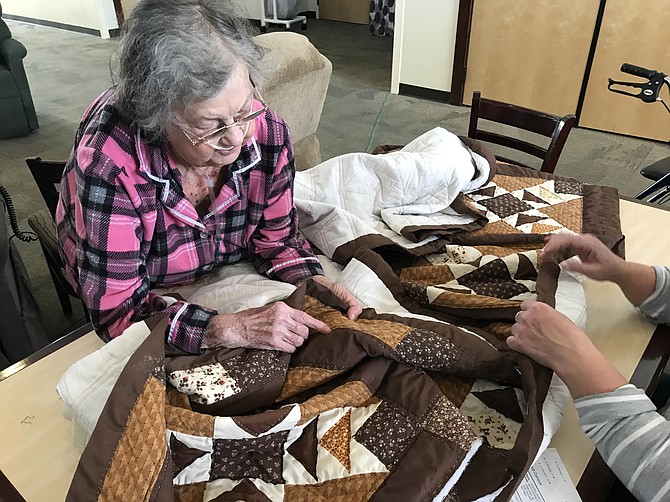I walk into the main room of the Marley House, our in-patient hospice facility, to find the clinical supervisor and volunteer coordinator sitting at a table, bent over a patchwork quilt, sewing brown satin edging around it by hand.
I had seen the email earlier in the day asking for anyone with spare time to stop by and visit with the patients, but I hadn’t expected a quilting bee when I walked in the door. I watch silently for a few minutes as they painstakingly sew tiny stitches through the batting and back fabric. The quilt is soft and weathered, with brown and beige calico triangles outlined in neat, cream-colored stitching.
Virginia sewed a quilt for her son 25 years ago. He used it so much that he wore it out. It’s been sitting in her closet for five years, waiting to be fixed up. She’s going back home tomorrow and is hoping she can surprise him with it as a Christmas present.
“So, what’s the story here?” I ask as I pull up a chair and smooth out an edge to look closely at the pattern. Heather straightens up and puts down her needle, while Cathy keeps sewing. She has to leave soon to visit some of our patients, but she’s determined to get her side done before she goes.
“It’s a quilt Virginia sewed for her son 25 years ago,” Heather says. “He used it so much he wore it out. It’s been sitting in her closet for five years, waiting to be fixed up. She’s going back home tomorrow, and is hoping she can surprise him with it as a Christmas present.”
“Wow, that’s a really special gift,” I say. “I didn’t know you knew how to quilt.”
“I didn’t until today,” she says. “It was kind of amazing. Turns out the woman in Room 7 used to run a quilt shop. When she came out and saw what we were doing, she gave us a few sewing tips. And now I’m quilting.” She shrugs and we both laugh. Nothing that happens at the Marley House surprises us anymore.
Virginia emerges from her room, decked out in purple plaid flannel pajamas, gray hair rumpled from napping. She rolls her walker up to the table, a big smile spreading across her face as she sees the staff hard at work on her precious quilt. “Oh my goodness, look how much you have done,” she says, clearly tickled by the progress. She’s been on hospice care for several months now, and is staying at Marley for a few days to give her caregivers at home a break. Her eyes twinkle as she carefully lowers herself into a nearby chair to watch.
“If you don’t get it done by the time I go home tomorrow, I’m going to have to leave it here with you and come back again,” she says, laughing. “That might be a threat.”
I ask her how long she has been quilting. “Seems like forever,” she says. She’s one of 11 kids, she tells me. Her mother was always sewing something, just like her mother did before her. “My mom made a lot of quilts. All the women did, but back then it was because we needed warm blankets for our beds. She used to make us things from old clothes she would save and take apart and sew into new clothes. I remember her making me a really warm snowsuit when we lived in Oklahoma. She taught me to sew when I was 10. But I’m 90 now, and my fingers don’t work well anymore.”
Cathy looks up from her sewing and shows her the edge that’s almost done. “I never expected this,” Virginia says quietly, smoothing out the fabric and tracing her fingers along the edges she had so carefully stitched a quarter-century ago. “I put a lot of love into this when I made it for my son 25 years ago. And now you ladies are sewing even more love into it.”
We let that sink in for a minute as I watch my coworkers’ hands gently pull needles and thread through the fabric, slowly making their way toward the corners of the quilt. I don’t want to leave the table, but I have to go back to work. I imagine Virginia’s son getting his quilt back from his mother and how much it will mean, knowing this is likely their last Christmas together. I wonder how many more hands will touch this quilt in the years to come, and the stories all those stitches hold.
My coworkers and the people we care for on hospice remind me each day that it takes so little to make a difference in this world. I think about the threads that connect us — how something frayed and broken can be made beautiful again by making time to sit together and work on it.

